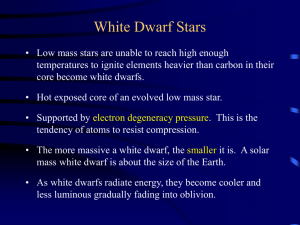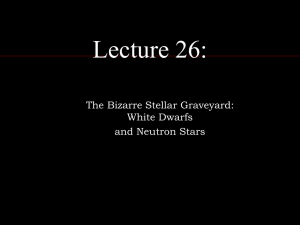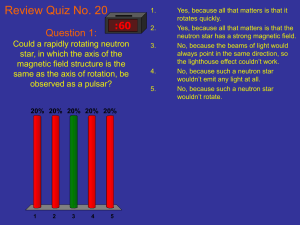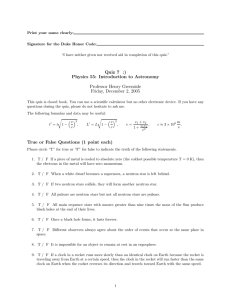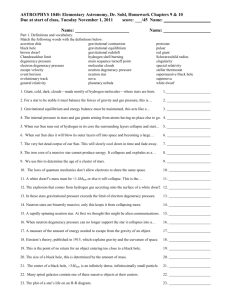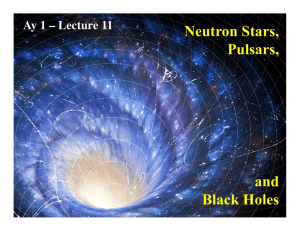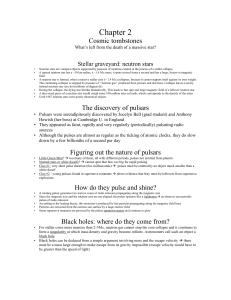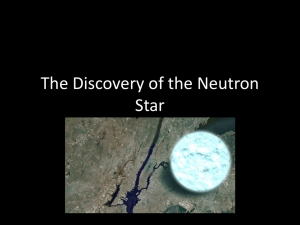Life and Evolution of a Massive Star
advertisement
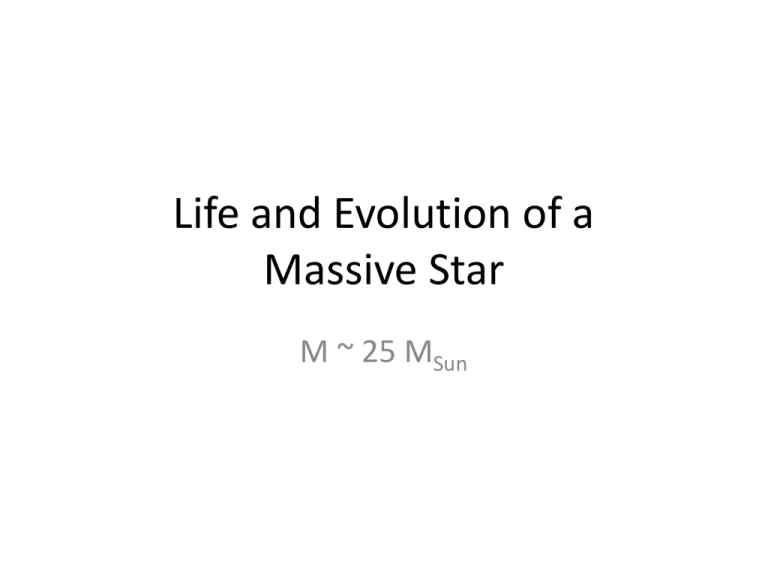
Life and Evolution of a Massive Star M ~ 25 MSun • Birth in a Giant Molecular Cloud • Main Sequence • Post-Main Sequence • Death The Main Sequence • Stars burn H in their cores via the CNO cycle • About 90% of a star’s lifetime is spent on the Main Sequence The CNO Cycle • Hotter core temp allows H to fuse with C, N, and O • More possibilities means faster reaction rate • Faster reaction rate means higher luminosity and a shorter life • • • • • • + 1H 13N + γ 13N 13C + e+ + ν e 13C + 1H 14N + γ 14N + 1H 15O + γ 15O 15N + e+ + ν e 15N + 1H 12C + 4He + γ 12C • Overall reaction: 4 1H 4He Supergiants • H burning in core stops • He core contracts • T high enough for He fusion, no need for degeneracy pressure • No He Flash Supergiants • Low mass stars cannot burn past He – Degeneracy pressure prevents core from contracting enough • High mass stars have more mass, so they can burn heavier elements – Degeneracy pressure never plays a part • As core burning element runs out, core contracts • Shell burning rate increases, star expands • Eventually core contracts enough for fusion of heavier element to begin • Shell burning slows and star contracts The Most Important Graph in the Whole Course E=mc2 Supernova: Type II • Fe core temporarily supported by electron degeneracy pressure • Gravity is stronger in high mass stars, crushes star further • Electrons combine with protons to form neutrons and neutrinos • Core collapses until neutron degeneracy pressure causes core to rebound • Tons of neutrinos push material out with a ton of energy (10,000 km/s) • Extra energy can create heavier elements than Fe Neutron Stars • Supported by neutron degeneracy pressure • M ~ 1-2 Msun • R ~ 10 km • ρ ~ 1014 g/cm3 • Vesc ~ 0.5c • Rotational periods range from msec – sec – Angular momentum Pulsars • Rapidly spinning neutron star • Tightly bunched magnetic field lines direct radiation out from poles • Magnetic axis not aligned with rotation axis; lighthouse effect • All pulsars are neutron stars, not all neutron stars are pulsars Pulsars • Nearly perfect clocks • Radiation takes angular momentum away, slowing down rotation • Pulsar dies when rotation gets too slow Millisecond pulsars/X-ray binaries • Gain angular momentum from material accreted from companion • Can be recycled pulsars • Very strong gravity makes disk very hot and bright in x-rays • X-rays pulse due to rotation • VIDEO X-Ray Bursters • Accreted H builds up into layer • Pressure below H layer is high enough for fusion, which makes He • If T reaches 108 K, He fusion can ignite, releasing tons of energy – P ~ 100,000 Lsun • Bursts last few seconds General Relativity Black Holes • Escape velocity – the speed necessary to climb out of a gravitational potential vesc 2GM r • Black holes have infinitely deep potential wells • Schwarzchild radius – the point in the gravitational well where vesc = c 2GM M Rs 2 3.0 km c M Sun Black Hole Formation • Neutron star can hold itself up against gravity with neutron degeneracy pressure • A star that is so massive that it collapses past the neutron degeneracy limit will become a black hole • The result is a singularity Cygnus X-1 • X-ray binary system • 18 Msun star orbiting with an unseen 10 Msun object • 10 Msun is much more massive than neutron degeneracy pressure can support • It must be a black hole Gamma Ray Bursts • First discovered in the 60s by US spy satellites looking for nuclear bomb tests • Astronomers first thought GRBs were just more energetic versions of X-ray binaries – X-ray binaries are concentrated in the disk of the Milky Way – GRBs are not, so they must be extragalactic Gamma Ray Bursts • Extremely short, luminous burst followed by long afterglow of lower-energy radiation • Most energetic outbursts in the Universe – Brighter than 1,000,000 Milky Ways Long GRBs • Appear to be correlated with core-collapse SN or galaxies with active star formation – Suggests that progenitors are SN from super massive stars – Formation of black hole • Burst lasts > 2 sec • Afterglow lasts several days to a month Short GRBs • Do not appear to come from SN explosions • Theory suggests that a double neutron star binary or neutron star and black hole binary collision would produce the energies necessary to make a short GRB • Burst lasts < 2 sec • No afterglow • Not well understood
